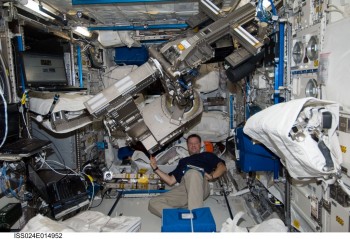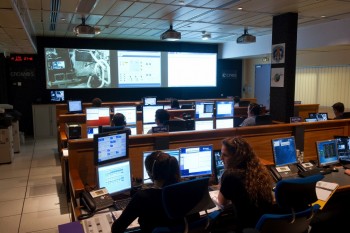The Muscle Atrophy Research and Exercise System, or Mares for short, is a muscle-measurement machine on the International Space Station that monitors astronauts’ muscles as they work out.
Muscle strength decreases during spaceflight and researchers need to know why this happens in order to prepare for long-duration missions and safe space tourism. Mares is a physiology instrument that offers detailed information about how muscles behave during spaceflight.
ESA astronaut Thomas Pesquet is setting up Mares in the European Columbus laboratory this week.

ESA astronaut Samantha Cristoforetti with MARES on the International Space Station. Credits: ESA/NASA
Colleague ESA astronaut Samantha did an initial test-run during her Futura mission on the International Space Station in 2015. She set up the machine and checked that the motors move as planned but did not take a place in the chair as an experiment subject.
ESA astronaut Andreas Mogensen performed a second part of the Mares commissioning during his ‘ iriss’ mission in 2015 by deploying the machine in its ‘ Ankle Configuration’ to get data on his ankle movements. This run validated the machine for more use for scientific experiments in the future.
Andreas was the first astronaut to use the machine to take measurements in space on himself but Thomas will be the first test subject whose data will be used by researchers for their study.
Mares is a big machine and is kept stowed away when not in use. Thomas will spend multiple days unpacking, setting up and using Mares.
Mares is a complex machine and has no equal that offers this type of fine control and measure the user’s reaction.
Ground control
During the days of work the CADMOS User Support and Operations Centre in Toulouse, France, will support the operations. User operators will be on hand to answer any questions the astronauts have and suggest solutions to any problems encountered.







Discussion: 10 comments
comment puis-je discuter avec Thomas Pesquet ?
Bonjour Louise,
Il n’est pas possible de contacter Thomas directement ; nous pouvons cependant lui transmettre des messages postés sur le blog.
Bonjour,
Une fois de retour sur terre combien de jours voire de semaines seront nécessaire pour que Thomas et les autres astronautes récupèrent leur force musculaire ?
Plus le séjour sera long plus la récupération sera longue ?
Merci pour votre réponse et bon courage à Thomas dans l’utilisation de cette machine !
Bonjour,
En effet la perte musculaire dépend de la durée du voyage. Elle est de l’ordre de 10% à 20% après de courtes missions spatiales (environ 7 jours), et peut
atteindre 40% après des vols spatiaux de plusieurs mois en l’absence de contremesures musculaires.
Dans notre cas Thomas réalise des exercices en résistance qui ont pour but de maintenir la masse musculaire.
La récupération dépendra également de l’activité de Thomas lors de son atterrissage sur Terre. En effet en situation de microgravité, la perte musculaire est accompagné d’une désorganisation de la fibre musculaire, qui entraîne la fragilisation de celle ci. Lors du retour sur terre, si Thomas marche et reste debout pour serrer la main au président, les contractions musculaires pour maintenir sa posture et lutter contre la gravité vont entraîner un déchirement des fibres musculaires désorganisé.
thomas pesquet, l’ ostéoporose est une maladie invalidante qui décèle risque de fracture selon le score de l’examen, vous même vous avez été confronte a cela ,quel a été le moyen pour y remédier que vos os puissent se consolider avec un séjour dans l’espace ,votre réponse servira a des milliers de femmes qui sont confrontés a des traitements avec des effets secondaires non négligeable,merci pour votre réponse en mp aussi,
Sublime les enfants vous suivent de manière attentionnés !je suis prof des écoles auprès d’enfants hospitalisés et vous représentez vous tous un rayon de soleil .
Merci de nous faire partager peut être vos travaux les aideront t ils et pourquoi pas les aider à guérir !
Envoyez nous de belles images et amusez vous bien”
Les ZINZINS DE L’ ESPACE À PROXIMA .
BONNE NUIT ET FAITES DE BEAUX RÊVES TOUT LA HAUT!
PS VOUS ÊTES PASSÉS PRÈS DE NOUS AUX ALENTOURS DE 1h cette nuit heure francaise terrienne.
CHALON sur SAONE pour ISS hourras !
Yup, that’ll do it. You have my aprptciaeion.
Very interesting. Good luck overthere.
Merci pour tout ce que vous publiez. On vous suivra jusqu’au bout.
Now I’m like, well duh! Truly thkaufnl for your help.